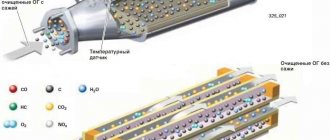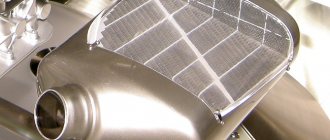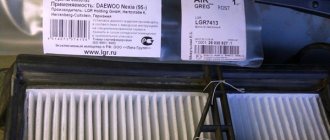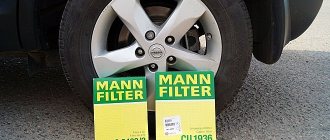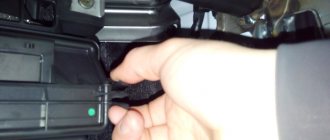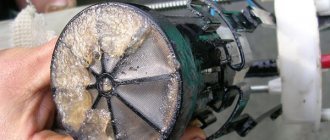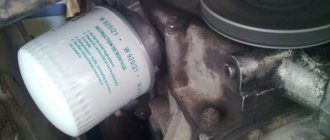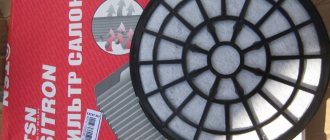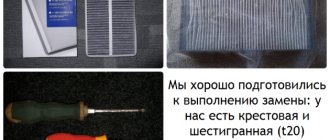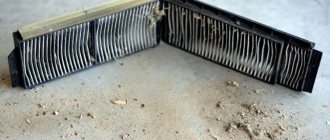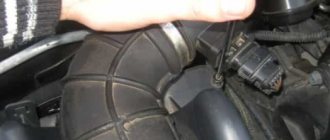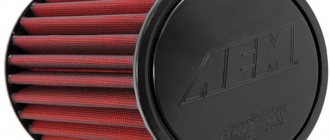Why is there no point in cleaning or rinsing the particulate filter?
How long does a new particulate filter last under our conditions?
How often does the diesel particulate filter burn out?
Why do particulate filters fail?
Why shouldn't you drive with a clogged particulate filter?
Why is it not enough to just knock out the particulate filter with a crowbar and put it back?
Is replacing the particulate filter with a new one guaranteed to solve the problem?
What does the EGR system do? Why is it needed?
Why is it necessary to remove a faulty particulate filter in Russian conditions on diesel cars?
Extensive experience with particulate filters gives us every reason to say that the particulate filter appeared early in Russia. We are not ready for it either technically (poor fuel quality and low level of maintenance of modern diesel engines) or morally (people are not ready to pay for an environmentally friendly car and are not encouraged by the state in this direction). As a result, the particulate filter, unfortunately, only promises problems for owners in Russia, since it is not able to work correctly in our conditions. Replacing a failed particulate filter with a new one does not guarantee the absence of problems during further operation.
Symptoms of a clogged particulate filter
Unstable engine operation at idle speed.
Sharp increase in fuel consumption.
Serious reduction in the dynamic performance of the vehicle during acceleration.
Increased smokiness of exhaust gases.
Lack of traction at high speeds.
Hissing and other extraneous sounds that are not characteristic of a running engine.
Increased oil level.
Turning on the Check signal on the instrument panel.
The failure of the soot trap can be signaled by all of the above signs, or individually.
Why is there no point in cleaning or rinsing the particulate filter?
This question disappears immediately if you see what’s inside the clogged particulate filter. The honeycomb design of the particulate filter will not allow liquid to pass through it. Try washing a piece of concrete. Karcher washing involves cutting off the top layer of ceramics. We need some really complex technological process that cannot be recreated in a garage. Serious technical centers will not deal with such a procedure. Its cost will be significant. We do not know any working solutions for such flushes.
Consequences of improper functioning of diesel particulate filter (DPF) regeneration on a Nissan Qashqai
This article will be a logical continuation of the conversation about malfunctions associated with the “sazhevik” (colloquial).
The full and correct name of this device is: diesel particulate filter (abbreviated DPF) - (
filter for cleaning from solid macroparticles in diesel exhaust gases); or “diesel particulate filter”, or “diesel particulate filter”, or “diesel particulate filter”.
“What is a particulate filter, and what is it for?”
I will not repeat myself and therefore refer the reader to my article published on the Legion-Avtodata website: “ Particulate filter ”
, autodata.ru/article/all/sazhevyy_filtr/
Clients sometimes ask, are there cars without soot? The question is logical, because the cost of replacing a particulate filter with a new one is high, several hundred dollars. Yes, there are such cars without a particulate filter. And I can’t give any hope: the vast majority of diesel cars are and will be produced with a particulate filter. It won’t be better, customers will have to take this as a “given” and get used to the fact that in order to operate such cars they will have to read and follow the included instructions (
below in the text
).
If you follow it, the car will serve “happily ever after” - within the limits allocated to it by the Manufacturer.
However, drivers who have a car with a soot, live in big cities and use their car in the “left for work - traffic jam - traffic jam - traffic jam - arrived” mode must keep in mind that such operating conditions are not provided for by the car manufacturer. Of course, on-board electronics frees a person from worries as much as possible, and the necessary procedure called “regeneration” occurs automatically. But regeneration requires certain conditions. And constant trips in the “traffic jam - traffic jam - traffic jam” mode lead to conditions where regeneration is poor or even interrupted.
This is exactly the car that came to us for diagnostics and repairs. First we heard a sound, it was getting closer and closer, and then the car itself appeared from around the bend. A completely new and modern car, Nissan Qashqai.
“Better turn it off,” we asked the client, because the sound of the running engine was too scary. A tank or tractor engine can work this way, but not a car engine. And here is the car in the box: the last years of production, in appearance it is not at all “killed”. But what a sound! What is the reason for this sound?
Before you do anything, you need to comprehend the situation. What kind of motor? Viewed:
How was the machine used? They asked. Everything is standard, everything is usual, there are no starting points: “Everything happened suddenly, the car was used in a standard way - parents drove, elderly people. The soot light came on several times, they drove onto the highway, drove the car at high speed and the light went out. And at some point it caught fire and never went out.”
Information from the Manufacturer's recommendations:
“Diesel Particulate Filter (DPF) Malfunction Indicator Light
• This warning light comes on when the ignition key is turned to the ON position. After the engine starts, the warning light should go out. This indicates that the system is working properly.
• If the DPF fault lamp comes on while the engine is running, this means that the amount of soot accumulated in the filter has reached a certain limit. If this happens, then as soon as possible, start driving at a speed of approximately 80 km/h until the control lamp goes out. In doing so, the legal speed limits must be observed. The soot particles accumulated in the DPF filter cannot be burned off when driving at lower speeds. Once the soot particles are completely burned, the DPF malfunction indicator lamp will go out.”
Well, we continue to study the malfunction: “What are our errors?” Now the electronics are so advanced that the engine is just about to sneeze, and the diagnostic system is ready to throw out a fault code. What's here?
Is it clear now. Even some thoughts appeared. Well, it’s not worth asking the client about seedlings and regeneration; most people don’t delve into all these subtleties and only come to their senses when the “rooster bites.”
We will remember:
· In the phase of exhaust gas release from the engine cylinder, an additional portion of diesel fuel is injected into the cylinders, which no longer takes part in pushing the piston - part of this fuel manages to leak past the piston rings into the engine sump
· Owners of cars with a particulate filter living in megacities, with constant traffic congestion, can rarely provide their car with such a condition, as a result of which regeneration can start much less frequently than necessary; It should also be taken into account that under no circumstances should you interrupt the regeneration process by turning off the engine
· Interrupted regenerations lead to accelerated overfilling of the particulate filter; it is already clogged so seriously that the regeneration process is not able to completely clean the particulate filter,-
autodata.ru/article/all/sazhevyy_filtr/
The key words here are: “an additional portion of diesel fuel is injected into the cylinders, which no longer takes part in pushing the piston - part of this fuel manages to seep past the piston rings into the engine sump.”
Well, let's see what's in the sump of this engine? And you'll excuse me for having to show something so dirty, but that's our job - it's an ordinary rag onto which they've dropped what's left on the dipstick:
Yes, it is clear that we are not a laboratory and did not send “this” there for analysis, but even without sniffing much, it became clear that there was “naked diesel fuel” in the pan.
And now it’s simple and accessible: “Due to a violation of the regeneration conditions, a lot of motor fuel got into the engine sump and the engine actually ran on diesel fuel.”.
You can listen to how he worked and the sound of his work on the audio recording:
https://yadi.sk/d/XdQCL8w0BywuP
But this is the work of the engine after a complete oil change was made, and that “tractor” sound that I spoke about earlier was much stronger and louder.
Clients ask: “How often should regeneration occur? How to understand whether it is happening correctly or not?
Here we can say this: “if regeneration occurs as usual, and this is 2-3 times during the period of changing the engine oil, then this is normal. And the amount of diesel fuel that gets into the pan is small, non-critical and taken into account by the Manufacturer. But when regeneration begins every 100-300 kilometers due to a clogged particulate filter, diesel fuel gets into the oil often and then the amount of motor fuel in the sump increases significantly. An example is this car. Regeneration on it occurred so often that the amount of diesel fuel exceeded all reasonable limits - the motor “knocked” (the sound of this motor: https://yadi.sk/d/XdQCL8w0BywuP). This is what long-term operation with a faulty particulate filter leads to.”
Well, I didn't do my job. Couldn't do it. Because it is impossible to carry out any work on reprogramming a car if it has such malfunctions: I need the engine to run for at least 40 minutes at high speeds, but this cannot be done if a mechanical malfunction is suspected. Now the car will be moved 10 meters to the right to our mechanic station, and only after it has been repaired will I continue work on reprogramming and programmatically disabling the particulate filter.
More articles about particulate filters Particulate filter Chip tuning. Software removal of particulate filter Chip tuning. Particulate filter – 2
Nitochkin Alexey Viktorovich
autotech Elektrostal (Moscow region), Mira Ave., 27a +7 https://el-chip.ru Union of Automotive Diagnosticians © Legion-Avtodata
Why do particulate filters fail?
Soot particles are captured by the honeycombs of the particulate filter without entering the atmosphere. Everything would be great, but the filter size is limited, and the amount of soot is increasing all the time. The solution is to somehow remove this soot from the filter. The simplest solution is to burn it. To do this, the engine control unit periodically issues a command to burn the particulate filter, injecting diesel directly into the particulate filter. In order for the soot in the filter to burn through, a high temperature is needed.
Frequent short trips around the city cannot warm up the particulate filter sufficiently. To start automatic regeneration, you need to drive on the highway for a long time so that the temperature sensor of the particulate filter determines the required temperature. Thus, regeneration does not occur or occurs poorly due to a weakly heated filter. Forcing drivers to purposefully create conditions for starting combustion is problematic.
Poor quality fuel. The amount of soot depends on the sulfur content of diesel. If the readings are too high, the filter clogs faster. As a result, regeneration occurs more often, and this leads to an increase in the oil level, since some of the fuel flows down the cylinder walls into the sump. The properties of such oil naturally deteriorate.
A faulty engine can also slow down the regeneration process.
An error in the EGR valve, a malfunction of the fuel equipment, or an incorrectly closed fuel tank cap - and there will be no regeneration. Meanwhile, soot continues to accumulate and its removal becomes increasingly problematic. It is not possible to completely burn through the soot; the residue inevitably accumulates. Worn engines are characterized by oil consumption due to tired piston rings and hardened valve stem seals. Oil from the cylinders enters the exhaust system and settles on the honeycomb of the particulate filter, which intensifies the process of clogging of the particulate filter, since additional carbon deposits are formed when the oil burns out.
In the experience of removing clogged particulate filters, the first section of the ceramic block suffers the most.
Choosing oil for an engine with a particulate filter
How to burn through a particulate filter?
It's simple. Get on the highway and drive at 3000 rpm for 15-20 minutes.
If you notice smoke, it means regeneration has begun and you shouldn’t turn it off, because it will be recorded as unsuccessful.
What oil should I use?
Engines with particulate engines use oils that meet one of the following tolerances:
- VW 504.00/507.00
- MB 229.51
- BMW Longlife-04
- Porsche C30
- RN 0720
And also corresponding to ACEA C3 or C4 approval.
C - new class - motor oils for diesel and gasoline engines that meet the latest stringent exhaust gas environmental requirements Euro-4 (as amended in 2005). These motor oils are compatible with catalysts and particulate filters. Actually, it was the innovations in European environmental requirements that became the reason for the reconstruction of the ACEA classification. Today there are three classes in this new category: C1-04, C2-04, C3-04.
The following oils meet these tolerances:
Oils for soot are low ash. The point is that the soot is burned out and ash remains, which does not burn, but clogs the honeycombs.
How does a particulate filter work?
Vehicles equipped with diesel engines are subject to strict emissions limits. This is the reason why diesel vehicles are equipped with particulate filters as standard. In Europe, even many older cars have DPF filters installed, and this is subsidized by the state.
The most common type of DPF filter is the “wall-flow” filter. They are usually made of ceramic material and their structure consists of several parallel channels. This technology is similar to a catalytic converter.
The main task of a DPF filter is to collect soot. Soot accumulates at the end of the channels. Gradually the exhaust gases will have less room to flow and this will cause an increase in pressure. Periodically, accumulated soot must be burned off. This process is called diesel particulate filter regeneration.
Regeneration is the process of removing accumulated soot from the DPF filter. This can occur passively (under the influence of exhaust gas temperatures during normal vehicle operation) or actively (forced), which causes very high temperatures in the exhaust system. This can be implemented in various ways. The most common option is when the temperature increase is achieved through later fuel injection or injection during the exhaust stroke.
DPF filters are equipped with several sensors. Pressure sensors are installed before and after the filter. They monitor the flow of exhaust gases. (the amount of accumulated soot that causes gas flow restriction). The lambda probe and temperature sensor are located nearby. They control combustion, temperature and emissions.
In addition to active and passive regeneration, there are two types of filters - with and without a catalytic converter. DPF filters with catalytic converter have a temperature sensor between the two filters (the catalytic converter and the DPF filter itself). DPF filters without a catalytic converter usually have a temperature sensor at the front.
The question arises - what is the problem? Even with an active and passive system for activating the filter regeneration process, raising the temperature to the desired value over a long period of vehicle operation does not always occur. Even with an active system, the regeneration process does not always start or does not occur properly (the soot is not completely burned). One of the reasons for soot accumulation is short car trips. If the regeneration process does not start, it will ultimately cause the vehicle to jerk and lose power. Additionally, excess pressure caused by a clogged DPF can damage the turbo or engine.
Currently, more and more motorists are choosing diesel cars for economic reasons. Low mileage and frequent urban driving can cause these problems and costly DPF filter replacement.
Share with friends
Tweet Facebook Google+ Pinterest
tvermaslo.ru
Why shouldn't you drive with a clogged particulate filter?
Firstly, due to the machine going into emergency mode. The car in this mode does not drive, but crawls. From experience, there are people who do not drive fast and are ready to continue moving further. Self-regeneration after the Check Engine icon or glow plug appears can no longer occur. With continued operation, soot quickly accumulates, completely clogging the engine exhaust system. Next, gases will begin to break through any available outlets, which can lead to breakdowns of the turbine, piston group, USR valve and crankcase ventilation system. We think that the above is already enough to make you no longer want to take such a risk. When the first signs of a diesel particulate filter malfunction appear, we do not recommend delaying a visit to the service center.
Will the exhaust pipe smoke after chip tuning?
Therefore, dear drivers, we officially declare to you that when you order professional services from the Hephaestus car service, when you order chip tuning from us, your car will not smoke! We will build the engine and exhaust system in the car so that the engine will work like a clock, the car as a whole will become more agile, and no systems will smoke. After chip tuning at the Hephaestus car service center, your car will no longer need either a particulate filter or the USR valve. And the exhaust pipe will no longer bother you with smoking.
Is replacing the particulate filter with a new one guaranteed to solve the problem?
Replacing a particulate filter is not cost effective and does not guarantee that the filter will last long. Some car enthusiasts believe that since a car was produced with a particulate filter, it means that without it it can no longer operate properly. This is wrong.
For example, the BMW X5 E70 of the first years of production was shipped to Russia without a particulate filter, and their counterparts from Europe had a particulate filter, American cars already came with a particulate filter and AdBlue urea.
The particulate filter and urea injection system are additional systems for improving the environmental friendliness of the car. Only with them can cars comply with legal European standards 4 and 5 in the countries where they are installed.
In Russia, cars without a particulate filter and urea will easily fit into existing European standards designed for fuel quality. You cannot have Euro-4 without the appropriate fuel. Cars with correctly removed particulate filter and AdBlue systems operate absolutely exactly according to all factory parameters and behave correctly.
Swirl flaps block part of the intake channel, thereby reducing the cross-sectional area of the channel. The amount of air passed through decreases slightly, while the speed of air movement increases, creating a vortex. This is necessary in order to improve the mixing of air and fuel in the cylinder. Everything is fine, but on most engines the swirl flaps are made of not very high quality plastic.
Over time, with runs of more than 100 thousand km, the build-up from the USR system deposited on the swirl flaps (after all, no one does the necessary maintenance flushing of the USR valve once every 60,000 km), together with the temperature, makes the plastic brittle, it breaks off and is sucked into the engine, followed by a major overhaul repair.
Without swirl flaps, the engine will lose torque in some medium modes, but will never die from pieces of plastic getting into the cylinders. The loss of torque can easily be compensated for by chip tuning, while you can save on related work on reprogramming the engine control unit for power and swirl flaps at the same time.
Simply removing the swirl flaps will not work, since often on runs the swirl flap controls have electronic and mechanical faults.
How is the particulate filter removed?
Removing the particulate filter is divided into two stages. First, you need to remove the ceramic matrix itself by opening the cylinder (“jar”) in which it is located. Secondly, you need to reflash the engine management system so that the control program thinks that the particulate filter is present and functioning normally. The NewstasEuroService auto repair shop offers services for high-quality physical removal of the particulate filter and can recommend specialists who will resolve issues regarding electronics.
Also, the NewstasEuroService auto repair shop can offer diesel particulate filter washing to owners of diesel cars. And for owners of gasoline cars, NewstasEuroService specialists will help resolve the issue with the catalyst: removing it and installing a blende.
The article was prepared with the assistance of the NewstasEuroService auto repair shop.
Evgeniy Dudarevaautospot.by
What does the EGR system do? Why is it needed?
Air by volume consists of 78% of the inert gas nitrogen, which under normal conditions reacts only with lithium. At high temperatures, nitrogen is oxidized, producing NOx oxides, and the higher the oxygen concentration, the more nitrogen oxides are produced.
The Exhaust Gas Recirculation (EGR) system is designed to reduce NOx in the exhaust gases by returning a portion of the exhaust gases to the intake manifold. Returning part of the exhaust gases to the intake manifold reduces the amount of oxygen in the fuel-air mixture and, thereby, reduces the formation of nitrogen oxides. However, this causes a drop in the effective engine power. Removing EGR in diesel engines is considered acceptable by a large number of people, including environmentalists. Removing the EGR system results in increased NOx levels, but hydrocarbon emissions, particulate matter (soot), carbon monoxide and carbon dioxide emissions are significantly reduced. Additionally, removing EGR results in increased fuel economy. Exhaust gas recirculated back into the cylinders adds wear-causing pollutants (soot and tar) to the engine and oxidizes the engine oil more quickly, negatively impacting engine life.
ELF EVOLUTION 700 TURBO DIESEL 10W40
ELF EVOLUTION 700 TURBO DIESEL 10W40 engine oil is specially developed and adapted for modern diesel engines, including those with direct injection, with and without a high-pressure battery fuel system. It meets ACEA B4, API CF, VW 501.01/505.00, MB229.1 specifications and can be used as diesel oil for most car manufacturers, both under normal and extreme operating conditions. Semi-synthetic ELF technology provides a high level of protective properties, thanks to which this motor oil reliably protects the engine from wear and deposits in any mode. ELF EVOLUTION 700 TURBO DIESEL 10W40 has a wide temperature range of application: it lubricates the engine well during cold starts, but remains effective in high temperature conditions, especially characteristic of direct injection engines.
ELF EVOLUTION 700 TURBO DIESEL 10W40
